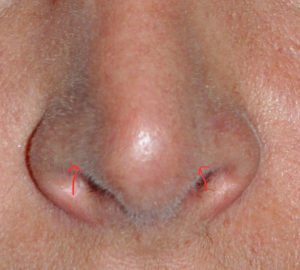Rhinoplasty is most commonly done today through an open approach. The wide exposure offered through the devolving of the nose offers many advantages, particularly in complex and revision noses. But there is a ‘price’ to pay for such open exposure and is not primarily the scar that it creates. (usually the transcolumellar scar truly heals in an inconspicuous manner.

In the July 2017 issue of the journal Plastic and Reconstructive Surgery, an article in this topic was published entitled ‘Preventing Soft-Tissue Triangle Collapse in Modern Rhinoplasty’. In this paper the authors review the anatomy of this small area of the nose, the common causes of alar notching in rhinoplasty and methods for its prevention and correction.Prevention is done initially by placing the margin rim incision far enough back from the alar rim during the opening of the nose. This is harder to do than placing it closer to the rim but is worth the extra effort. During closure of the rhinoplasty elimination of the dead space can be done with soft tissue grafts tucked behind the incision line. If one seems any slight nostril asymmetry or suspects that alar notching will happen, cartilage grafts can be placed into the soft triangle area. (alar contour or alar rim grafts)
Secondary correction of alar notching always involves cartilage grafts. The question is whether cartilage grafts alone or a combined cartilage-skin (chondrocutaneous) graft is needed. An alternative approach is to also use injectable fillers. While it may temporary in many cases, repeated injections can result in more sustained results in some patients.
Dr. Barry Eppley
Indianapolis, Indiana


